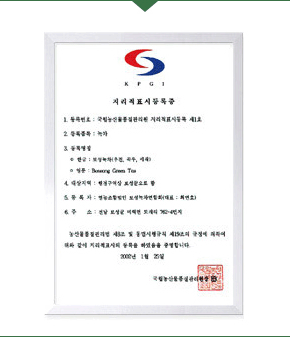Green Tea Rating
Korea's green tea samples will cheotmul car, in mid-May to early-June order picker picker to lift the end of April (gokwoo) - May to early 3-4 times a year so that dumulcha. The car on the lift picking in late June and July called Summer car (three mulcha). Finally, picking the kkeutmul late August (cheoseo) - Early September (backlog) in the leaves harvested production to count large in comparison with bomcha Following are widely used in everyday life eumryu.
Classification of Green Tea
| Woojeon tea |
Saejak |
Jungjak |
Daejak |
Yeop tea |
| Collected before April 20 |
May to early harvesting |
Taken in mid-May |
Taken in late May |
June-July harvesting |
Woojeon tea (雨前茶)
The finest handmade tea with tea leaves collected before Gok-u. We make woojeon tea with first tea leaves which survived from harsh winter, so tastes and flavors are fresh and mellow. Because of its low production, we only make limited amount.
Saejak (細雀)
Good tea is made of leaves called Chang and Ki which still not open their leaves yet and are collected in the first ten days of May. Saejak is also called jakseol tea because its shape is similar to sparrow' tongue. It's the most popular tea, and you can enjoy colour, flavor and taste.
Jungjak (中雀)
It's made of chang and ki which open their leave in the first ten days of May. We collect couple of leaves and make jungjak. It has affluent colour and taste.
Daejak
It's made of leaves collected in the last ten days of May. Leaves are harder than Junjak so its rough but contains green tea components. In this time of the season, days are longer and the temperature increases, so a component called tannin increases which gives bitter taste of tea.
Yeop tea
Mostly consisted with hard leaves. So, people drink it instead of Soong-nung.
Classification according to the sampling period (manufacturing period)
Green tea is usually right front, gokwoo, sejak, jungjak, sharing a masterpiece.
Early spring when young leaves are coming out in April the first buds 1 Gen 2 groups (trial 2 leaves) are harvested by hand and the sprout (gokwoo pre-woojeoncha, gokwoo time - gokwoo car) harvesting period is taken beginning from 5-7 Willing to date (of the leaf size: right front (1.5 ~ 2cm), gokwoo (the 2 ~ 2.5cm).
Sejak is late April to early May until the first sprouts window 03 (1 Shim 3 open) collected the young leaves by hand and sampled period is 10 days (in leaf size: 2.5cm ~ 3cm)
Jungjak May until mid-May to early harvesting sprouts 1 Genesis 3 caused the young leaves by hand (machine) and sampling period is about 10 days (the size of the blade: 3cm more)
Magnum is May to mid May until the end of the first sprout new leaves collected Genesis 3 caused by hand (machine) and sampling period is about 10 days (the size of the blade: 3cm more)
Classified according to the time chaeyeop (Preparation group)
▶ Cheotmul difference: that between one chaeyeop from mid-April to early May chamat soft and good flavor and aroma.
▶ Dumulcha: The chamat from mid-June to late June between one chaeyeop strong flavor drops.
▶ Three mulcha: from August to early August this astringency of chaeyeop one that there is some difference between the mid-Arin strong taste.
▶ Yes mulcha: Late September from fiber to have chaeyeop between early October this lot less rough shape taste.
Classified according to the degree of fermentation
Deok the tea leaves in a pot, or steamed with steam to destroy the oxidizing enzymes and ensure that the green tea made retained 'fire fermented tea', polyphenols in tea by the Rigi and stirring poems in the sun or indoors is 10-65% degree is called the fermented tea made "semi-fermented tea ', after which destroy the enzymes in the tea leaves, tea happen again induced to enter into force in the growth of microorganisms during the deposition made by air tea is called' post-fermented tea.
Fire fermented tea (0%): steam steaming tea into (jeungjecha), deokeo in the pot (deokeumcha) is a way to destroy that green tea made oxidase retained
▶ Jeungjecha: Manor industry (Sulloc, Sulloc Halla), green tea Tech, Bo Jeddah (Boseong green tea), etc.
▶ Deokeumcha: Manor industry (Sulloc agate, downpours, etc.), for stationary, saemgol Tea, Banya pluralism, such as green tea Myeongga
Semi-fermented tea (10-65%): the sun or the difference made by the fermentation 10-65% polyphenols by stirring poems and Rigi in the room
▶ White tea (white tea - light fermented tea: 10-30%): baihao yinzhen, including baekmodan
▶ Wagons (wagons - light fermented tea: 10-30%): Jasmine tea, kkotcha rose, gardenia kkotcha, globalization tea
▶ Pojong car (pojong tea - the tea fermentation: 20-40%): TIEGUANYIN car, repair, sympathy ohryongcha, Mui car
▶ Ryongcha (ohryongcha-of-fermented tea: 50-60%): Backhoe ohryongcha (Taiwan, China - Fujian, Guangdong)
Fermented tea (black tea 85% and above): degree of fermentation that represents a search of the car, such as scarlet as a strong astringent is more than 85% ※ the world's three major tea: Darjeeling, India (Dazzeling), China gimun (祁門), Sri Lanka Uva (Uva) tea
After primary fermentation: after destroy the enzymes, such as green tea and tea preparation method for depositing happen again induced to enter into force the growth of microorganisms in the air created by linking the tea leaves
▶ Yellow Tea (黃 茶): junshan yinzhen, wet dreams gamrocha
▶ Heukcha (黑茶): Black tea, tea yukbo, tteokcha


